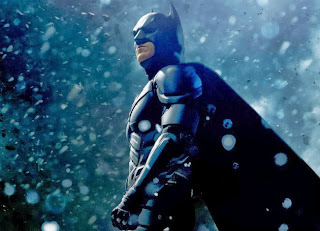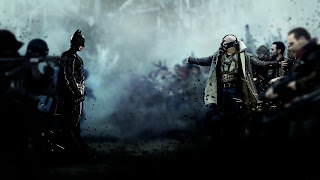★★★
It takes some hutzpah for a director with a fine art bent like Steve McQueen to undertake a movie about slavery, and Twelve Years a Slave has a lot of good ideas. One of McQueen’s best decisions is to show how the institution affected everyone involved with it rather than simply focus on the plight of the slave. Of course, we repeatedly see how horrible it was to live as a slave; it was a horrible institution. Love and family are disrupted as we see not only in Solomon’s situation after his enslavement but also in the situation of Eliza, who is stripped of her children in a New Orleans slave sale after having been her previous master’s favorite. We see the horrible beatings that slaves receive when Solomon, and later Patsey, are whipped, and there is even torture when Solomon is left hanging from a tree with his toes barely touching the ground. Epps’ drunken dragging in of his slaves to dance for a midnight “party” is another form of abuse.
The film's handling of Solomon’s hanging points to another aspect of slavery – its effect inside the slave community. While Solomon is hanging, struggling to stay alive by dancing on tiptoe, other slaves continue their lives only catching furtive glances of him from the corners of their eyes, and kids play outdoors in plain sight of the torture. Only one woman risks punishment by bringing Solomon some water. The level of horrific violence that Solomon experiences is not only familiar to the slave community, but the community knows that resisting it will only bring added pain. Solomon is told this very clearly on the boat to New Orleans, and he even repeats it in trying to console Eliza after the woman’s separation from her children.

But the breadth of McQueen’s portrayal of the institution of slavery extends beyond those enslaved
to include the enslavers, and what we see is not a monolith of racism. Solomon’s first master, Ford, tries to buy Eliza’s children when he buys her in order to keep the family together, but he can’t afford them all. At his estate, Ford shows some respect for Solomon’s opinion over that of a racist craftsman, Tibeats. And we see that even masters have limits when Ford has to sell Solomon to Epps in order to protect his slave from the anger of Tibeats. Ford warns Solomon that he can’t protect him alone.
But the most compelling portrayal of a slaveholder is Michael Fassbender’s Epps. In fact, this character is the fullest, most complex character in the film. Epps is a powerful man, rigidly beating underperforming slaves and subjecting his slaves to humiliating behavior like rousing them to dance for him when he is drunk late one night. This dancing scene also shows other aspects of the complex Epps, though. He drags his slaves in to dance because he lacks friends and companionship on his isolated plantation. His wife not only hates him, but she berates him and insults his honor in front of the slaves here, showing his own weakness, insecurity and hesitancy in this episode. And the cause of her behavior is that, although Epps feels that slaves are inferior, he searches for consolation by sexually assaulting Patsey, seeking a complex solace that involves both power and attraction. The extremes of Epps’ moods and behaviors make him the most complicated and compelling element of Twelve Years a Slave.
Which is the central problem with this film. The main character, Solomon, lacks complexity and emotional resonance with the audience. Often, he’s merely a vehicle for showing us what slavery is all about, but even when he’s involved in the action, we don’t see the complexity of motivation in him that we see in Fassbender’s Epps or, for that matter, in Lupita Nyong'o's Patsey, who ranges from despair and submission to defiance. Twelve Years a Slave initially gives us a formal Solomon who doesn't engage us, and he become even more distant from us when he’s a slave. You have to think that McQueen has directed Chiwetel Ejiofor to make Solomon reticent; in scenes like Solomon’s pleading his innocence about writing a letter or his resistance to whipping Patsey, we see that Ejiofor can indeed connect with the audience. But though most of Twelve Years a Slave, the reticence of the main character keeps us from being fully engaged in the film. Epps is a fully-formed character, Patsy is complex and conflicted, but Solomon is just a means for the movie to make a statement. The formal disconnect between the cardboard main character and these two dynamically realized ones prevents Twelve Years a Slave from being aesthetically satisfying.
There is a lot in this movie to recommend it. There are moments of beauty when McQueen is willing to let his camera linger and take in what’s around him. Images like the swamp sunset with silhouettes of cypresses and moss show the beauty that coexists with the horrible institution of slavery. Solomon’s letter (and hope) burns slowly, turns into red glow, diminishes and then goes out. Such measured moments pace the film and offer touches of beauty amid the grimness. But the decision to prevent us from empathizing with Solomon, coupled with the masterful creation of the complicated, conflicted, insecure, tyrant Epps and his equally complex slave Patsey, creates a weakness at the center of this ambitious work.
It takes some hutzpah for a director with a fine art bent like Steve McQueen to undertake a movie about slavery, and Twelve Years a Slave has a lot of good ideas. One of McQueen’s best decisions is to show how the institution affected everyone involved with it rather than simply focus on the plight of the slave. Of course, we repeatedly see how horrible it was to live as a slave; it was a horrible institution. Love and family are disrupted as we see not only in Solomon’s situation after his enslavement but also in the situation of Eliza, who is stripped of her children in a New Orleans slave sale after having been her previous master’s favorite. We see the horrible beatings that slaves receive when Solomon, and later Patsey, are whipped, and there is even torture when Solomon is left hanging from a tree with his toes barely touching the ground. Epps’ drunken dragging in of his slaves to dance for a midnight “party” is another form of abuse.
The film's handling of Solomon’s hanging points to another aspect of slavery – its effect inside the slave community. While Solomon is hanging, struggling to stay alive by dancing on tiptoe, other slaves continue their lives only catching furtive glances of him from the corners of their eyes, and kids play outdoors in plain sight of the torture. Only one woman risks punishment by bringing Solomon some water. The level of horrific violence that Solomon experiences is not only familiar to the slave community, but the community knows that resisting it will only bring added pain. Solomon is told this very clearly on the boat to New Orleans, and he even repeats it in trying to console Eliza after the woman’s separation from her children.

But the breadth of McQueen’s portrayal of the institution of slavery extends beyond those enslaved
to include the enslavers, and what we see is not a monolith of racism. Solomon’s first master, Ford, tries to buy Eliza’s children when he buys her in order to keep the family together, but he can’t afford them all. At his estate, Ford shows some respect for Solomon’s opinion over that of a racist craftsman, Tibeats. And we see that even masters have limits when Ford has to sell Solomon to Epps in order to protect his slave from the anger of Tibeats. Ford warns Solomon that he can’t protect him alone.
But the most compelling portrayal of a slaveholder is Michael Fassbender’s Epps. In fact, this character is the fullest, most complex character in the film. Epps is a powerful man, rigidly beating underperforming slaves and subjecting his slaves to humiliating behavior like rousing them to dance for him when he is drunk late one night. This dancing scene also shows other aspects of the complex Epps, though. He drags his slaves in to dance because he lacks friends and companionship on his isolated plantation. His wife not only hates him, but she berates him and insults his honor in front of the slaves here, showing his own weakness, insecurity and hesitancy in this episode. And the cause of her behavior is that, although Epps feels that slaves are inferior, he searches for consolation by sexually assaulting Patsey, seeking a complex solace that involves both power and attraction. The extremes of Epps’ moods and behaviors make him the most complicated and compelling element of Twelve Years a Slave.
Which is the central problem with this film. The main character, Solomon, lacks complexity and emotional resonance with the audience. Often, he’s merely a vehicle for showing us what slavery is all about, but even when he’s involved in the action, we don’t see the complexity of motivation in him that we see in Fassbender’s Epps or, for that matter, in Lupita Nyong'o's Patsey, who ranges from despair and submission to defiance. Twelve Years a Slave initially gives us a formal Solomon who doesn't engage us, and he become even more distant from us when he’s a slave. You have to think that McQueen has directed Chiwetel Ejiofor to make Solomon reticent; in scenes like Solomon’s pleading his innocence about writing a letter or his resistance to whipping Patsey, we see that Ejiofor can indeed connect with the audience. But though most of Twelve Years a Slave, the reticence of the main character keeps us from being fully engaged in the film. Epps is a fully-formed character, Patsy is complex and conflicted, but Solomon is just a means for the movie to make a statement. The formal disconnect between the cardboard main character and these two dynamically realized ones prevents Twelve Years a Slave from being aesthetically satisfying.
There is a lot in this movie to recommend it. There are moments of beauty when McQueen is willing to let his camera linger and take in what’s around him. Images like the swamp sunset with silhouettes of cypresses and moss show the beauty that coexists with the horrible institution of slavery. Solomon’s letter (and hope) burns slowly, turns into red glow, diminishes and then goes out. Such measured moments pace the film and offer touches of beauty amid the grimness. But the decision to prevent us from empathizing with Solomon, coupled with the masterful creation of the complicated, conflicted, insecure, tyrant Epps and his equally complex slave Patsey, creates a weakness at the center of this ambitious work.














































